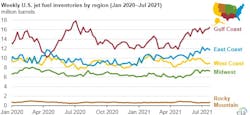EIA: Rising US jet fuel refinery production contributes to high jet fuel inventories
The increase in US air travel this year has led to an increase in US demand for kerosene-based jet fuel, but increased jet fuel production has outpaced the higher demand, resulting in higher-than-average jet fuel inventory levels, according to the US Energy Information Administration (EIA).
Strong demand for petroleum products produced along with jet fuel, particularly gasoline and diesel, has encouraged refineries to process more crude oil to produce those high-demand products. Higher refinery runs have also resulted in increased jet fuel production. Since the first week of May (ending May 7, 2021), US refinery runs have increased by nearly 6% (855,000 b/d), and refinery jet fuel production has increased by nearly 8% (102,000 b/d).
Although demand for jet fuel has grown from last year, current demand remains below the pre-pandemic 5-year (2015–2019) average. As of July 23, jet fuel product supplied was 14.8% lower than the pre-pandemic 5-year average.
Increased jet fuel production and lower product supplied have contributed to rising inventories. As of July 23, the combined total US jet fuel inventory was 9.9% higher than the 5-year (2016–2020) combined average. In addition, on July 23, the combined total gasoline inventory was down 0.6%, and the combined total distillate fuel oil inventory was 6.8% below the 5-year combined average. Along with increased production, relatively less jet fuel has been withdrawn from inventory since May 2021, which has contributed to increased jet fuel inventory.
The higher-than-average inventories vary, depending on the region. Jet fuel inventory levels in the Rocky Mountain region (PADD 4) and the West Coast region (PADD 5) have been decreasing and are near their previous 5-year averages. Inventory levels in the East Coast region (PADD 1), Midwest region (PADD 2), and Gulf Coast region (PADD 3) have been increasing and are near or above their 5-year highs.
Recent news articles report that transportation constraints are limiting the amount of jet fuel going from primary inventories to airports and other points of consumption in the western regions (the Rocky Mountains and West Coast). These constraints include limited pipeline or trucking capacity and restrictions on the volume of jet fuel that can be moved from the terminal to consumers, particularly those at more remote destinations. These constraints would also have some, although more limited, effect on the amount of jet fuel product supplied.
